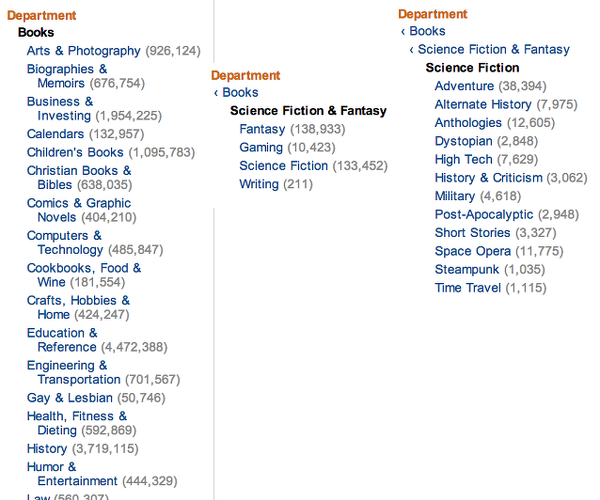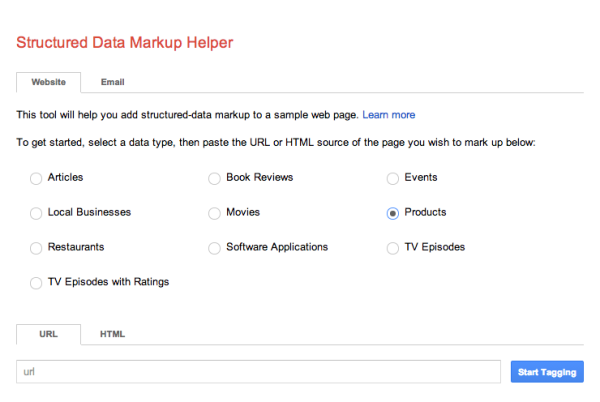6 Essentials Of E-Commerce SEO You’re Probably Still Missing
Shopping cart SEO can range from the simple to seemingly impossible. In a competitive landscape, how do you separate your store from the competition? How do you balance SEO and usability? Here are six things I look at early in any shopping cart SEO project. 1. Maintain A Simple Site Structure Make it easy for […]
Shopping cart SEO can range from the simple to seemingly impossible. In a competitive landscape, how do you separate your store from the competition? How do you balance SEO and usability?
Here are six things I look at early in any shopping cart SEO project.
1. Maintain A Simple Site Structure
Make it easy for customers to get right into the site and find products. For most online stores, I recommend three levels of primary menu navigation:
- The home page
- Department pages
- Product pages
https://shopname.com/department/product/ https://shopname.com/shirts/polo-shirts/
Some shops may warrant an additional category level to get important keywords into your site-wide navigation.
https://shopname.com/department/category/product/ https://shopname.com/mens-wear/shirts/polo-shirts/
The rule of thumb is to keep your store as simple as possible; don’t needlessly complicate your menus.
For enterprise-size stores that sell thousands of items across multiple departments with products that must be broken into smaller and smaller sub-groups, I suggest the traveling magnifying glass approach to navigation.
The traveling magnifying glass, my own term, is how I describe navigation that expands and collapses depending on where you are in the shopping cart. These navigational links define specifications that help visitors narrow choices (ex. iPhone, Android, Windows or Blackberry). This is especially helpful when there would otherwise be page-after-page of products to view. Here are three key features of the traveling magnifying glass:
- Maintain your top level navigation
- Use sidebar navigation to show sub-category breakouts and options
- Do not show menu links for options that have been rejected by the visitor; instead, use breadcrumb navigation for easy backtracking
As users move deeper into product subcategories, do not keep all the previous options in your sidebar navigation. If you do, your menu will become visually complicated. For SEO, you want to push PageRank or authority deeper into the site, toward the products, not backwards into multiple levels of navigation.
Amazon.com makes tremendous use of the traveling magnifying glass. In their books department, Amazon offers numerous categories. When you click on Science Fiction and Fantasy those all disappear and you’re offered Fantasy, Gaming, Science Fiction or Writing. Pick Science Fiction, and Amazon presents you with a dozen sub genres. Each time you move deeper into the bookstore, the previous choices disappear.

Amazon offers links to many sets of options: format, author, book series and more. A selection from any links-group (as opposed to checkboxes) simplifies the menu by removing the unselected options. This is the opposite approach from stores that never remove options and keep piling on new ones as visitors dig deeper.
Another thing worth noting about Amazon.com is that each of the sidebar menu choices double as a keyword. Search Google for Science Fiction and Fantasy. Amazon ranks #3 as I write this. The URL in the SERP is the same as the canonical tag URL in the HTML of the page that appears when you click Science Fiction & Fantasy in the sidebar menu.
As you select options, Amazon creates new URLs and adds the selected options in the title tags. This optimizes thousands of pages for long-tail queries. I’ll write more about title tags later.
2. Use Canonical Tags
Store URLs and shopping cart SEO have always had a contentious relationship. Many carts use query strings or other URL treatments to populate pages with specific content or options. I’ve worked on major brand websites with expensive shopping cart software that uses illegal characters and syntax.
Shopping carts and website administrators have legitimate reasons to customize URLs, for example, to include internal referral parameters for analytics. The challenge to SEO is that modified URLs can create issues like spider blocks, duplicate content and decreased keyword relevancy.
Things got easier in 2009 when Google, Yahoo and Microsoft announced support for the canonical link element. Any page that can be reached by more than one URL, whether those URLs appear in links on your site or not, should contain a unified canonical tag. Hopefully, your shopping cart CMS will take care of this for you.
3. Use Simplified Keyword URLs
Before I get into simplified URLs, I want to clarify I’m writing about the URLs which appear in search engine indexes. These may come from actual links or canonical tags. Obviously, if a URL appears in a canonical tag, it must work when typed into the address bar.
What is a simplified keyword URL?
- It features keywords, usually the department , category or product name
- It separates words with dashes (though not in the domain itself)
- It foregoes query strings and non-alphanumeric characters
- It removes stop words
Let’s look at some examples:
Departments
https://shopname.com/department/ https://shopname.com/womens-shoes
This is just the domain plus the department name.
Categories
https://shopname.com/department/category/ https://shopname.com/womens-clothing/shoes/
Just the domain, department and category.
Products
https://shopname.com/product-name/ https://shopame.com/nike-air-jordon-1101a-sports-shoe
Products are where things get a little different. Notice I recommend only the domain plus the product name. The reason for this is that one product may appear in more than one department or category. To avoid duplicate content, the best practice is to use one URL only combined with dynamic breadcrumb navigation customized according to the visitor’s entry path.
Not all shopping carts permit this simplified URL. When this is the case, you can select one version of the URL and use it as the canonical. I try to find the one which makes the best department, category and product match.
Notice I added sports shoe in the product name. This is an intentional keyword insertion.
4. SEO Department, Category & Product Names, Titles & H1 Tags
The key to selecting good departments and categories is to get as many of each as close to the top of your site structure as possible, ensuring you also adhere to good usability principles. I worked on a women’s clothing store that had clothes, shoes and accessories as their departments. I was able to move most of the clothing categories – pants, blouses, dresses and jackets – up to the department level.
Think about how people look for your products. A favorite record store uses departments like EDM & House, Alternative, Rock and Disco. Not only does their navigation make it easy for visitors to drill down to the albums and songs people want; it optimizes their site for some great keywords.
Use the same strategy for both departments and categories.
When naming individual products, combine the actual product name with its most common keyword. If you sell tennis racquets, use the model and the category: Wilson Pro Staff Six One 100L BLX Tennis Racquet.
As a basic standard, the title tag and H1 should match the name of the department, category or product. You may have additional pages based on user options.
/science-fiction-fantasy-books /science-fiction-fantasy-paperback-books /science-fiction-fantasy-hardcover-books /science-fiction-fantasy-ebooks
In this situation, include the option or options in the URL, title and H1 for department and category level URLs. Once you get to individual products, however, you should drop any options so you use that one unique product page.
5. Create Your Own Unique Descriptions
When working with major brands and retailers, I always look for unique and useful product descriptions. The two biggest sins I’ve seen are product descriptions shared across multiple websites and thin product descriptions.
Don’t Share Product Descriptions
Here is a typical occurrence. Big Brand, Inc. sells from their own website plus through various retailers or affiliates. The copy writing team writes one description for every product, and the descriptions end up on Big Brand’s website, multiple online retailer sites and on affiliate websites.
Click on this Google search to see what I mean:
“Based on Federer’s Pro Staff Six One 90, the Wilson Pro Staff Six One 100 BLX”
Now, look-up this tennis racquet on Google by name:
Wilson ’12 Pro Staff Six.One 100L BLX Tennis Racquet
Notice that each listing has a different description. Give yourself an immediate edge-up on the competition by writing your own unique product descriptions. If you are the manufacturer, write one description for your own website and another to supply retailers and affiliates.
Write Rich Product Descriptions
The second major sin is thin product descriptions, usually in the form of a short descriptive sentence or two and a list of specifications. At the very least, create a list of features and adjoining benefits to develop an illustrative description.
Picture where your product will be used or worn and use that to create a visual story. Search engines want to reward quality content. Product descriptions are one of those things busy copywriters like to rush and use the same familiar language. You don’t have to be Hemmingway. Just be better than the other websites.
6. Use Schema.org
Schema.org is a machine-readable markup search engines use to recognize and classify content. Here is an example I created with Raven SEO’s Schema Creator for Products.

Google is big on this and offers help in Webmaster Tools.

I’m still amazed how many online shops forego Schema.org or any machine-readable markup. In most shopping carts you can implement this into your templates so it auto populates for each product. Set it and forget it.
Contributing authors are invited to create content for Search Engine Land and are chosen for their expertise and contribution to the search community. Our contributors work under the oversight of the editorial staff and contributions are checked for quality and relevance to our readers. The opinions they express are their own.
Related stories
New on Search Engine Land